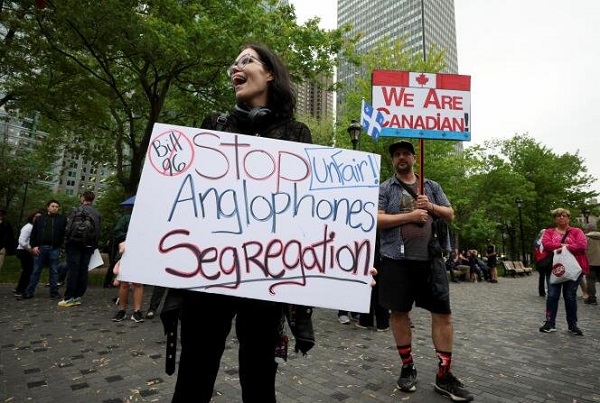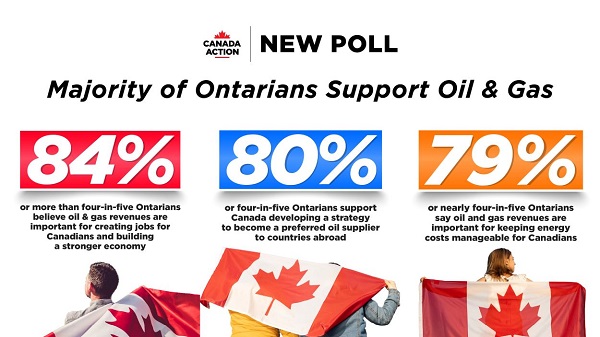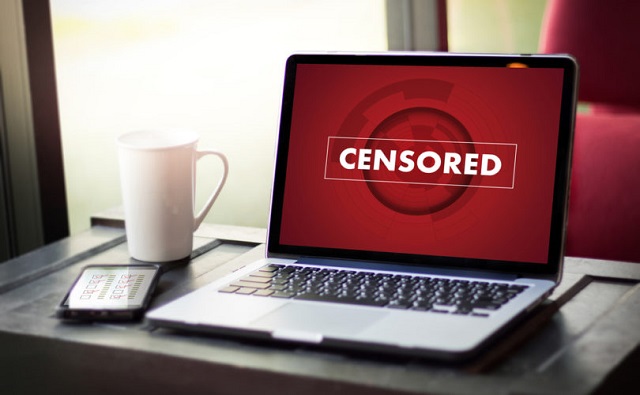Bruce Dowbiggin
Québec: Still Speaking In Tongues, Cashing Your Cheques

Lather. Rinse. Repeat. The cycle of Québec’s byzantine language politics continues. Nothing seems to change. The culture authoritarians propose. The anglos protest. More people make the decision to leave the province. The Québec-based prime minister takes off for Tofino.
The latest bagarre concerns a policy that has leaders of Québec’s English community worried they might not be entitled to health treatment in English. The purpose of this latest culture cleansing was, as always, to re-assert the primacy of French is the delivery of services. Because nothing works better than unworkable impositions to insoluble problems.
The language of the directive was, at best, inelegant. For instance, immigrants to the province are only eligible to receive health care in a language other than French for the first six months after their arrival. Also, says the document, a language other than French can only be used in healthcare settings when “health, public safety or the principles of natural justice require it,”— including in emergencies.
The directive also stipulates that members of “Quebec’s historic anglophone community” must provide a certificate proving their eligibility to attend English school in the province if they want to receive all medical services exclusively in English. (Wouldn’t wearing stars on their clothes suffice?)

Predictably the remaining Québec anglos, whose gullibility on language diktats knows no bounds, reacted in fear. For decades they’ve tried to be good little citoyens, sending their kids to French immersion, learning to order their smoked meat in the approved tongue, assuming settler guilt for winning at the Plains of Abraham. Voting Liberal. And what has it gotten them?
Trudeau Liberal stooge Anna Gainey tried to salve their feelings. “It is clear that the confusion and uncertainty created by the directive is likely to have adverse consequences that cannot be ignored,” she wrote. “Clarity is urgently needed. The choice of language should continue to belong to the patient.”
As you might expect, the tongue troopers denied any malign intent in their ongoing push to keep Québec a French enclave— even if that’s what the policy says. Three Québec ministers reached out to say the new directive does not restrict healthcare access for English speakers. “The government of Québec imposes absolutely no linguistic conditions in health care settings before providing health care in English to anyone who requests it,” they wrote in The Gazette.
In other words, take two pilules and call me in the morning. Plus cà change.
What’s most remarkable is that no one seems to acknowledge that this ongoing cleansing of the anglo fact in Quebec, a process launched by the election of René Levesque’s PQ in 1976, is a lingering 20th-century artifact, irrelevant in a current world where regional language and culture laws are subordinate to globalist commissars. In that world a unilingual Québec is a minnow that won’t last a minute.
As an example, this week’s X chat between its founder Elon Musk and Americans GOP candidate Donald Trump was seen as so threatening to world order that pencil-necked EU digital chief Thierry Breton warned Musk that, under EU laws, “X is obliged to ensure ‘all proportionate and effective mitigation measures are put in place regarding the amplification of harmful content’.”
In other words we are criminalizing speech we don’t like, and you might be charged. Breton’s concern was that “around 100 million X users in the EU” might be polluted by something other than his propaganda. (In fact, the chat had nearly a billion engagements worldwide.) Musk responded to Breton with a Tom Cruise line from Tropic Thunder that said, “Literally, fuck your own face!”

Meanwhile in Québec’s dreamland, the bunkered solitudes of traditional culture perpetuate their waltz over preserving a French culture abandoned centuries ago by the mother country. Hundreds of thousands of native Quebeckers have tired of this folly, leaving for other provinces and nations where the position of an apostrophe doesn’t bring down the weight of a government on you. An anglo rump conveniently remains to serve as punching bags for the autocrats in the National Assembly.
Equally preposterous is that Canada itself remains mired in this morass, incapable of entering the 21st century, because its eastern elites are petrified of admitting that Québec’s game is up. Principal among them is Justin Trudeau whose sovereign duty is preserving the status quo handed him by his father. That means the protection of Québec’s sweetheart deal under the equalization plan, wasting billions on a bilingual mandate in places where the most French thing is the fries and keeping police away from Québec’s sacred corporate sector.
Canada still has an explicitly separatist party in the federal parliament, sucking up federal funds while dreaming out loud about destroying the union. But they know that they’ll never have to go rogue in the current milieu. They’re protected by a double standard that allows them to take money from the rest of Canada (suck) while undermining the federation (blow).
While no one is anxious to see Canada rupture, patience has warn thin, says the Fraser Institute. “From 2007 and 2022, Albertans’ contributed $244.6 billion to the federal government in taxes and other payments in excess of the money Ottawa spent or transferred to Alberta — more than five times as much as was contributed (on net) by either British Columbians or Ontarians.
The other seven provinces, and most notably Québec, were net recipients of federalism, meaning the amount of revenue collected by the federal government in those provinces was exceeded by the amount of money spent or transferred by Ottawa back to the provinces.” All the while with Quebec attacking the energy sector that fuels their lucrative equalization hustle.
The persistent presence of the province among the takers is a feature, not a bug in the Trudeau master plan. In whatever language you say it, pandering to Québec and its linguistic fetish is unsustainable. But who will bell that cat when the current stalemate serves everyone in Ottawa?
Bruce Dowbiggin @dowbboy is the editor of Not The Public Broadcaster A two-time winner of the Gemini Award as Canada’s top television sports broadcaster, he’s a regular contributor to Sirius XM Canada Talks Ch. 167. His new book Deal With It: The Trades That Stunned The NHL And Changed hockey is now available on Amazon. Inexact Science: The Six Most Compelling Draft Years In NHL History, his previous book with his son Evan, was voted the seventh-best professional hockey book of all time by bookauthority.org . His 2004 book Money Players was voted sixth best on the same list, and is available via brucedowbigginbooks.ca.
Bruce Dowbiggin
In Contentious Canada Reality Is Still Six Degrees Of Hockey

There’s an observation that only two things bind modern Canada. The federal equalization scheme and hockey, The past year illustrated that equalization is on tenuous ground with talk of separation in Quebec, Alberta and Saskatchewan.
Hockey, conversely, drew the nation closer at the moment that Donald Trump read the riot act to Canada’s elites. After the mens junior squad bombed out of the Junior Hockey championships for a second straight year, a new crisis emerged. To cover their purging of Justin Trudeau and insertion of Mark Carney as PM. the notorious Mike Myers’ Elbows Up homage to Gordie Howe’s elbows was appropriated by the Liberals (In true Woke wonk fashion, Howe never carried his elbows in Carney’s crash position. He kept them by his sides for greater power.)
In February’s Four Nations Cup, played at the height of tension between the two nations, Americans launched a Shoresy brawl in the first game, won easily by Team USA 3-1. As we wrote at the time, “Despite public calls for mutual respect, the sustained booing of the American national anthem and the Team Canada invocation by MMA legend Georges St. Pierre was answered by the Tkachuck brothers, Matthew and Brady, with a series of fights in the first nine seconds of the game.
Three fights to be exact when former Canuck J.T. Miller squared up with Brandon Hagel. (All three U.S. players have either played on or now play for Canadian NHL teams.) Premeditated and nasty. To say nothing of the vicious mugging of Canada’s legend Sidney Crosby behind the U.S. net moments later by Charlie McEvoy.”
Perhaps the least-appreciated aspect of the tension was the booing of the Star Spangled Banner by Canadians who have many Americans playing in their nation’s NHL squads. Leftist Toronto Star scribbler Bruce Arthur, bristled, “You’re damn right Canadians should boo the anthem.”
But in the rematch for the tournament title Canada reversed the tables, winning 3-2 in OT. The rush of nationalistic pride— from people who just weeks before were at each other’s throats over Indigenous claims and pipelines—fed a demographic topsy-turvy that swung Liberals 20 points in the polls, defeating the stunned Conservatives and coming within a few seats of a majority under Carney. Such was the hockey-fed insanity that NDP voters abandoned their far-left mantras to vote for a man who’d only weeks prior was a director of international giant Brookfield Investments.

One other byproduct of the Four Nations was the defrocking of Canadian legend Wayne Gretzky, who’d made a public show of his support for Trumping the 2024 presidential election. He was coldly rebuffed as he shook hands with the Canadian players before the Final game. It was not the finish for Gretz. He was reviled for golfing with The Donald in November, and then mocked for his faceplant appearance at the FIFA 2026 World Cup men’s draw. We wrote, “Gretzy apparently thinks there are countries called “North Mack-a-donia” and “Cur-ack-ow.” Other stabs at geography were almost as tortured.
Bitter Canadians could put up with him sucking up to Trump (he was mentioned as being in the crowd at the DC Xmas tree lighting) but failing geography is unforgivable. The week that started with Gretzky in a photo golfing at POTUS’s Jupiter, Florida, golf course was ending with him pummelled for his abuse of nations with different-sounding names. The Wayne Gretzky Center For Kids Who Want To Talk Good. “

In between the Gretzky episodes, two men who’d shaped modern hockey passed away. In September, on the anniversary of his participation in the 1972 Canada/ USSR series, Ken Dryden died at age 78. “For a generation that watched him develop he was likely the quintessential modern Canadian. Son of a charitable community figure. Educated in the Ivy League. Obtained his law degree. Served as a federal cabinet minister. Author of several definitive hockey books (The Game is perhaps the best sports non-fiction in the English language). Executive of the Toronto Maple Leafs. And more.
“He was on the American telecast of the 1980 U.S. Miracle On Ice at Lake Placid. And the radio broadcast of the 1976 Canada Cup. Ubiquitous media source. Loyal to Canada. And crucially, a son, husband, father and grandfather. If you’d created a model for the citizen of Canada of his times it was Ken.”
A less-loved figure in hockey— but no less significant— died the week after Dryden with the passing of former NHL Players Association director Bob Goodenow, who led the union through three momentous labour fights. Our take: “Tenacious, fearless and bold describes his style. Cuddly and sentimental he was not. The former lawyer and player agent for Brett Hull was not impressed by NHL self-dealing, and he said so. The Harvard product made a bad enemy after he succeeded Alan Eagleson in 1992.

“Today’s players owe him so much for finally giving them self respect. While players in other leagues ate steak, NHL players ate KD. Our book on the topic Money Players is an exhaustive catalogue of dirty dealing and deceit.
“Goodenow convinced hockey players that to earn their worth in the market they had to stick together in negotiations. It would be trying as fans and the media took the owners’ line under new commissioner Gary Bettman when they locked out players in 1994. He didn’t suffer reporters who were NHL echo chambers or old-timers who pined for their good old days of making $1000 a year.
CBA negotiations have never been the same. Player salaries have never been the same. Media covering hockey has never been the same. Eagleson was criminally convicted in the U.S. and Canada for the self dealing revealed by Conway and us. That’s an impressive legacy. RIP the man who reformed pro hockey from within.”
In a hangover story stretching back seven years, the sexual assault trial of the World Junior Hockey gold medalists of 2018 was a field day for narratives in the media and the courtroom. The facts, meanwhile, were stowed away beneath the surface of social media. As we reported in our June 28 column: “Outside diligent reporters such as Katie Strang of The Athletic and Rick Westhead of TSN, the media universe simply assumed guilt in the five players, because. hockey… Social media liberally smeared them as rapists, symbols of women’s degradation.

The five players on trial had been unfairly branded as criminals by Hockey Canada which rushed to condemn them in a quick civil settlement of EM’s charges. HC never consulted them about their side of the story before surrendering the cash. In the end, Ontario Justice Maria Carroccia found EM not “credible or reliable” enough to send the players to jail. While scolding their behaviour she declared the young men not guilty. It was a courageous decision, knowing it would prompt backlash. The Globe&Mail led the charge, declaring “After the Hockey Canada verdict Advocates fear survivors will fall silent”.
As 2026 dawns the outlook for Canadian NHL teams looks bleak. Just two teams would make the postseason today— Edmonton and Montreal— while Toronto, Ottawa, Winnipeg, Calgary and Vancouver wallow below the cut line. Which leaves the Elbows Up crowd pining for a replay of the Four Nations as Canada heads to the Olympic tournament. Don’t expect Wayne Gretzky to ride to their rescue.
Bruce Dowbiggin @dowbboy is the editor of Not The Public Broadcaster A two-time winner of the Gemini Award as Canada’s top television sports broadcaster, his 2025 book Deal With It: The Trades That Stunned The NHL And Changed Hockey is now available on Amazon. Inexact Science: The Six Most Compelling Draft Years In NHL History, his previous book with his son Evan, was voted the seventh-best professional hockey book of all time by bookauthority.org . His new poetry collection In Other Words is available via brucedowbigginbooks.ca and on Kindle books at https://www.amazon.ca/dp/1069802700
Bruce Dowbiggin
Be Careful What You Wish For In 2026: Mark Carney With A Majority

“The unifying theme that enables the Liberal party to maintain its hold over Canada is persistent anti-Americanism…I hope Canadians finally mature, acknowledge that we are neither superior nor inferior to the United States, and abandon our collective national inferiority complex.” Conrad Black quotes a friend.
Canadian media have almost always been reflexively anti-American. Fair enough. Abandoned by Britain they needed to push back. But the real fear of being consumed by the rebel colonies to the south has morphed into a fear of Donald Trump reminding Canada that it has been riding first class while paying economy.
Bashing noisy, bumptious America has always been good business if you owned a Canadian newspaper or television/radio network. The performative worship of Canadian leaders who cocked a snook at the Yankees led, in recent times, to the open-mouthed support for the fatuous Trudeaupian line of monarchs. As Ray Davies sang, “each one a dedicated follower of fashion.”
Since Pierre “The Bold” Trudeau succeeded Lester Pearson and ascended to the throne of the Family Compact in 1968, Canadian policy from Viet Nam to Trump has become “What are the Americans doing? Then let’s do the opposite”. Sample of spite: CBS TV pulled a controversial 60 Minutes news story —but it aired in Canada after being leaked by pissed-off CBS employees.
Yes, there was the brief Harper interregnum when Canada actually fought a military campaign alongside the U.S. in Afghanistan. But mostly it was Jean “Golf Balls” Chretien sitting out the Iraq War.
Alas, all good things must end. Or at least pause. People were starting to notice that Justy was a Chinese trusty, his Montreal riding campaign funded by hundreds of Chinese “businessman” from far away. The tragi-comic Trudeuapian succession hit a speed bump with Mark Carney being brought in to domesticate Canada in manner satisfactory to Brookfield and the EU.

But no one is betting the Libs won’t turn to a third generation of Quebec fashionistas— in the form of another Trudeau progeny— when all else fails.
As usual caustic Conrad Black sums up Canada best. With Quebec and Alberta talking separation he quotes a friend on the state of the nation. “What exists instead is a Liberal Party that manages — often quite poorly — the finances of a collection of provinces and territories, while relying on its media apparatus to shape and safeguard its narrative. It resembles a hedge fund supported by an image consulting firm.” (Insert your convict felon/ anglo wannabe reference here.)
There is no doubt that, as 2025 skulks out, the “image-consulting firm” painting rosy pictures of the Laurentian Elite is in for a a challenge. Justin thought using Trump as his pretext could achieve peace by buying up the lads and lasses of the fourth estate. It worked with Covid and the Truckers Convoy as the column writers/ panel hosts dutifully wrote it like he called it (even as the international press chided Trudeau.).
But even those good times didn’t last, forcing the Libs to do a presto-chango before Justin could lead them to a catastrophic defeat in the spring election. Once more, faced with Trump’s aggressive posture toward trade with Canada, the press closed ranks over Elbows Up, portraying CPC leader Pierre Poilievre as Dick Dastardly.
But new polling shows that the burst of enthusiasm for more Liberal pantomime is wearing thin. The new “new” trade deal promised with Trump has dissipated. The threat to private home ownership in B.C. by government’s indigenous land concessions has sent a chill through the middle class. The NDP fainting goats who bought Elbows Up are headed back to Crazytown, likely under Avi Lewis.
Now, at last, the reckoning promised by the Conservatives’ 20-point lead in polling this time last year may be at hand. While the diehards will go their graves mumbling land acknowledgements and 32 pronouns, there is hope that the under 60s— who emphatically support the Tories— will force change.
What change? Tristan Hopper in the National Post suggests that one place to start reforming the jalopy of Canadian government is in the oceans of money lavished on cause-related political leeches. Seeing the Bondi Beach slaughter by ISIS radicals many now question how long before Toronto or Montreal experiences a similar tragedy at the hands of jihadis who are lavishly supported by tax money.
Yes, not all Muslims in the West are terrorists. But almost all terrorists in the West are Muslim. Hate-spewing Hamas groupies from college faculty are regularly allowed major intersections with police protection as they promise to wipe out infidels. Till now it’s been poor form to even mention, let alone criticize, this pantomime.
Withdrawing financial aid to these groups and their academic fellow travellers would immediately rob these brigands of their impact. The cries of despair from cutting the cord would also expose those in the Commons who have coddled these vipers with grants and ministries.
Similar hacking at the slush money aimed at every other form of leftist posing— from trans to indigenous to illegal immigrants— would also mark the end of free money. Of course there will be caterwauling from the Elizabeth May Free Lunch crew. But with the threat of Canada coming apart with Quebec and Alberta/ Saskatchewan headed for the door those usual dissenting voices will be muted.
Only one thing stands in the way of this culling. That is PM Mark Carney coercing one more MP to cross the floor to his party, cementing its majority status for up to four more years. While the At Issue panels slap their flippers in glee at Poilievre’s demise, the rest of the nation will be less enthralled with the new realities of censorship, trade and housing.

As Stephen Punwasi states. “People in Canada can’t afford homes & prices can’t fall because debt was securitized with widespread fraud—so taxpayers will subsidize foreign speculation. It’s like they hired the mayor of Vancouver to run housing. Oh—they did, eh? Kids, run.”
Bruce Dowbiggin @dowbboy is the editor of Not The Public Broadcaster A two-time winner of the Gemini Award as Canada’s top television sports broadcaster, his 2025 book Deal With It: The Trades That Stunned The NHL And Changed Hockey is now available on Amazon. Inexact Science: The Six Most Compelling Draft Years In NHL History, his previous book with his son Evan, was voted the seventh-best professional hockey book of all time by bookauthority.org . His new poetry collection In Other Words is available via brucedowbigginbooks.ca and on Kindle books at https://www.amazon.ca/dp/1069802700
-

 Bruce Dowbiggin2 days ago
Bruce Dowbiggin2 days agoIn Contentious Canada Reality Is Still Six Degrees Of Hockey
-

 Alberta1 day ago
Alberta1 day agoThe Canadian Energy Centre’s biggest stories of 2025
-

 Business2 days ago
Business2 days agoCanada needs serious tax cuts in 2026
-

 Business1 day ago
Business1 day agoOttawa Is Still Dodging The China Interference Threat
-

 Business1 day ago
Business1 day agoMinneapolis day care filmed empty suddenly fills with kids
-

 Business1 day ago
Business1 day agoDisclosures reveal Minnesota politician’s husband’s companies surged thousands-fold amid Somali fraud crisis
-

 Business1 day ago
Business1 day agoResurfaced Video Shows How Somali Scammers Used Day Care Centers To Scam State
-

 Business2 days ago
Business2 days agoDOOR TO DOOR: Feds descend on Minneapolis day cares tied to massive fraud









